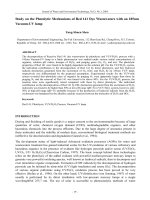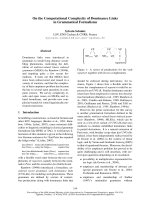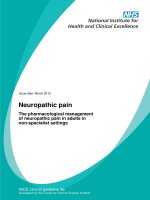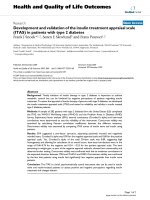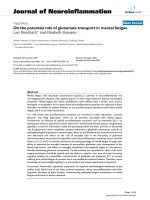WHO guidelines on the pharmacological treatment of persisting pain in children with medical illnesses docx
Bạn đang xem bản rút gọn của tài liệu. Xem và tải ngay bản đầy đủ của tài liệu tại đây (1.45 MB, 172 trang )
WHO
guidelines on
the pharmacological
treatment of persisting
pain in children with
medical illnesses
WHO
guidelines on
the pharmacological
treatment of persisting
pain in children with
medical illnesses
WHO Library Cataloguing-in-Publication Data
Persisting pain in children package: WHO guidelines on the pharmacological
treatment of persisting pain in children with medical illnesses.
Contents: WHO guidelines on the pharmacological treatment of persisting pain in children with medical
illnesses - Three brochures with important information for physicians and nurses; pharmacists; policy-makers
and medicines regulatory authorities, hospital managers and health insurance managers - Dosing card - Pain
Scale for children (4 years of age and up) - Pain Scale for children (6 - 10 years) - Wall chart for waiting rooms
1.Pain-drugtherapy.2.Pain-classication.3.Painmeasurement.4.Analgesics,Opioid.5.Drugs,Essential.
6.Drug and narcotic control. 7.Palliative care. 8.Child. 9.Guidelines. I.World Health Organization.
ISBN9789241548120 (NLMclassication:WL704)
© World Health Organization 2012
Allrightsreserved.PublicationsoftheWorldHealthOrganizationareavailableontheWHOwebsite
(www.who.int)orcanbepurchasedfromWHOPress,WorldHealthOrganization,20AvenueAppia,1211
Geneva27,Switzerland(tel.:+41227913264;fax:+41227914857;e-mail:).
Requests for permission to reproduce or translate WHO publications – whether for sale or for noncommercial
distribution – should be addressed to WHO Press through the WHO web site
( />Thedesignationsemployedandthepresentationofthematerialinthispublicationdonotimplytheexpression
of any opinion whatsoever on the part of the World Health Organization concerning the legal status of any
country, territory, city or area or of its authorities, or concerning the delimitation of its frontiers or boundaries.
Dottedlinesonmapsrepresentapproximateborderlinesforwhichtheremaynotyetbefullagreement.
Thementionofspeciccompaniesorofcertainmanufacturers’productsdoesnotimplythattheyareendorsedor
recommended by the World Health Organization in preference to others of a similar nature that are not mentioned.
Errorsandomissionsexcepted,thenamesofproprietaryproductsaredistinguishedbyinitialcapitalletters.
AllreasonableprecautionshavebeentakenbytheWorldHealthOrganizationtoverifytheinformation
contained in this publication. However, the published material is being distributed without warranty of any
kind,eitherexpressedorimplied.Theresponsibilityfortheinterpretationanduseofthemateriallieswith
the reader. In no event shall the World Health Organization be liable for damages arising from its use.
Design and layout: paprika-annecy.com
Printed in France
<1
CONTENTS
ACKNOWLEDGEMENTS 6
Donors 6
ABBREVIATIONS AND ACRONYMS 7
GLOSSARY 8
EXECUTIVE SUMMARY 10
Clinical and policy recommendations 10
Future research 10
Reading guide 11
INTRODUCTION 13
1. CLASSIFICATION OF PAIN IN CHILDREN 16
1.1 Introductiontoclassicationofpain 17
1.2 Painclassicationsystems 18
1.2.1Pathophysiologicalclassication 18
1.2.2Classicationbasedonpainduration 20
1.2.3Etiologicalclassication 21
1.2.4Anatomicalclassication 21
1.3 Causesandclassicationofpainassociatedwithspecicdiseases 23
1.3.1CausesandtypesofpaininchildrenwithHIV/AIDS 23
1.3.2Causesandtypesofpaininchildrenwithcancer 24
1.3.3Causesandtypesofpaininchildrenwithsicklecelldisease 25
2. EVALUATION OF PERSISTING PAIN IN THE PAEDIATRIC POPULATION 26
2.1 Clinicalexamination:painhistoryandphysicalexamination 27
2.2 Expressionofpainbychildrenandappropriatepainassessmentmeasures 29
2.3 Documentationofpain:theuseofpainmeasurementtools 30
2.4 Deningcriteriaandselectingapainmeasurementtoolinclinicalsettings 33
2.5 Assessmentofotherparametersinchildrenwithpersistingpain 34
2.6 Overcoming the challenges of assessing persisting pain in children 35
3. PHARMACOLOGICAL TREATMENT STRATEGIES
PATIENT-LEVEL GUIDELINES FOR HEALTH PROFESSIONALS 36
3.1 Principlesforthepharmacologicalmanagementofpain 37
3.2 Treatingpainusingatwo-stepstrategy 38
3.2.1Therststep:mildpain 38
3.2.2Thesecondstep:moderatetoseverepain 38
3.2.3Considerationofthetwo-stepapproach 39
> 2
3.3 Treatingpainatregularintervals 40
3.4 Treatingpainbytheappropriateroute 40
3.5 Tailoringpaintreatmenttotheindividualchild 40
3.5.1Non-opioidanalgesics 40
3.5.2Opioidanalgesics 41
3.6 Strongopioidsessentialinpaintreatment 42
3.7 Choiceofstrongopioids 42
3.8 Immediate-releaseandprolonged-releaseoralmorphine 43
3.9 Opioidswitching 44
3.10 Routesofadministration 45
3.11 Treatmentofbreakthroughpain 46
3.12 Tolerance,withdrawalanddependencesyndrome 46
3.13 Opioidoverdose 47
3.14 Adjuvantmedicines 50
3.14.1Steroids 50
3.14.2Bonepain 50
3.14.3Neuropathicpain 51
3.14.4Painassociatedwithmusclespasmandspasticity 52
3.15 Researchagenda 53
4. IMPROVING ACCESS TO PAIN RELIEF IN HEALTH SYSTEMS 54
4.1 The right to health, the right to be spared avoidable pain 55
4.2 International regulations on opioid analgesics 55
4.3 Dimensionsofanationalpaintreatmentpolicy 56
4.4 Financing pain relief within the national system 56
4.5 Estimatingneedsforpainrelief 57
4.6 Saving resources by treating pain 58
4.7 Pain management coverage 59
4.8 Human resources for pain management 59
4.9 What treatment should be available 60
ANNEX 1. PHARMACOLOGICAL PROFILES 62
A1.1Fentanyl 63
A1.2Hydromorphone 66
A1.3Ibuprofen 69
A1.4Methadone 70
A1.5Morphine 73
A1.6Naloxone 76
A1.7Oxycodone 78
A1.8Paracetamol 80
<3
ANNEX 2. BACKGROUND TO THE CLINICAL RECOMMENDATIONS 82
A2.1Developmentprocess 83
A2.2Pharmacologicalinterventions 84
A2.2.1Atwo-stepapproachversusthethree-stepladder 84
A2.2.2Paracetamolversusnon-steroidalanti-inammatorydrugs 86
A2.2.3Strongopioidsessentialinpaintreatment 87
A2.2.4Choiceofstrongopioids 88
A2.2.5Prolonged-releaseversusimmediate-releasemorphine 90
A2.2.6Opioidrotationandopioidswitching 91
A2.2.7Routesofadministration 92
A2.2.8Breakthroughpain 93
A2.2.9Adjuvantmedications:steroids 95
A2.2.10Adjuvantsinbonepain:bisphosphonates 95
A2.2.11Adjuvantsinneuropathicpain:antidepressants 96
A2.2.12Adjuvantsinneuropathicpain:anticonvulsants 97
A2.2.13Adjuvantsinneuropathicpain:ketamine 98
A2.2.14Adjuvantsinneuropathicpain:localanaesthetics 98
A2.2.15Adjuvantsforpainduringmusclespasmorspasticity:
benzodiazepines and baclofen 99
A2.3Non-pharmacologicalinterventions 99
ANNEX 3. BACKGROUND TO THE HEALTH SYSTEM RECOMMENDATIONS 100
ANNEX 4. EVIDENCE RETRIEVAL AND APPRAISAL 104
A4.1 GRADEproles 105
A4.2 Studiesretrievedonhealthsystemrecommendations 123
A4.3 Studiesretrievedinthethirdstepoftheevidenceretrievalprocess 124
ANNEX 5. RESEARCH AGENDA 128
ANNEX 6. OPIOID ANALGESICS AND INTERNATIONAL CONVENTIONS 130
A6.1 UNdrugconventionsandtheirgovernancesystem 131
A6.2 TheSingleConventiononNarcoticDrugsandopioidanalgesics 132
A6.3 Drugmisuseversuspatientneed 132
A6.4 Competentnationalauthoritiesundertheinternationaldrugcontroltreaties 133
A6.5 TheConvention’srequirementsfornationalestimatesofmedicalneedforopioids 133
A6.6 Theimportanceofreliableestimates 134
A6.7 Domesticmanufactureofstrongopioidanalgesics 134
> 4
A6.8 Theimport/exportsystemforstrongopioids 135
A6.9 Requirementsforimport/exportauthorizationsorcerticates 136
A6.10Thereportingsystemfollowingexportation,importationandconsumptionofopioids 137
A6.11Distributionofstrongopioids 137
A6.12Usualrequirementsforprescribinganddispensingopioids 138
ANNEX 7. LIST OF CONTRIBUTORS TO THIS PUBLICATION 140
A7.1Guidelinesdevelopmentgroupmeeting 141
A.7.2Othercontributors 142
A7.3Declarationofinterestandmanagementofpotentialconictofinterest 143
SUMMARY OF PRINCIPLES AND RECOMMENDATIONS 146
REFERENCES 148
INDEX 156
<5
LIST OF TABLES
Table 1.1 Common sensory features suggestive of neuropathic pain 19
Table 1.2 Differentiating features of nociceptive and neuropathic pain 22
Table 2.1 List of self-report measuring tools for pain intensity 31
Table3.1Non-opioidanalgesicsforthereliefofpaininneonates,infantsandchildren 41
Table3.2Startingdosagesforopioidanalgesicsforopioid-naiveneonates 48
Table3.3Startingdosagesforopioidanalgesicsinopioid-naiveinfants(1month–1year) 48
Table3.4Startingdosagesforopioidanalgesicsinopioid-naivechildren(1–12years) 49
Table3.5Approximatedoseratiosforswitchingbetweenparenteralandoraldosageforms 50
LIST OF BOXES
Box0.1DenitionofqualityofevidenceaccordingtoGRADE 14
Box0.2Interpretationofstrongandweakrecommendations 14
Box2.1Summaryofquestionsbythehealth-careproviderduringclinicalevaluation 29
Box2.2Multidimensionalassessmentofepisodicpaininchildrenwithsicklecelldisease 33
Box2.3Step-by-stepguidanceforadministeringandinterpretingaself-reportpainscale 34
Box3.1Excludedmedicineforpainrelief 39
Box3.2FormulationsofmorphinelistedintheWHO model list of essential
medicines for children, 2010 43
Box3.3Guidanceforselectionandprocurementofmorphineoralformulations 44
LIST OF FIGURES
Figure 1.1 Diagram showing the many dimensions of pain modifying the
transmissionofnoxiousstimulitothebrain 17
Figure2.1Algorithmonevaluationofpaininthepaediatricpopulation 28
FigureA6.1Stepsinopioidimport/exportprocedures 136
(ForGRADETablesseeAnnex4,SectionA4.1(page105).)
> 6
ACKNOWLEDGEMENTS
TheseguidelineswereproducedbytheWorldHealthOrganization(WHO),DepartmentofEssential
MedicinesandPharmaceuticalPolicies,AccesstoControlledMedicationsProgrammeincollaboration
withtheDepartmentofChronicDiseasesandHealthPromotion,theDepartmentofMentalHealthand
SubstanceAbuse,theDepartmentofHIV,theDepartmentofEssentialHealthTechnologies(currently:
Department of Health Systems Governance and Service Delivery), and the Department of Child and
AdolescentHealthandDevelopment.ThesedepartmentswererepresentedontheWHOSteeringGroup
on Pain Treatment Guidelines.
TheWHOGuidelinesReviewCommitteeprovidedinvaluablesupporttotheAccesstoControlled
MedicationsProgrammewhiledevelopingtheseguidelines.
The guidelines were developed with contributions from:
• theExpandedReviewPanelindeningthescopeoftheguidelinesandinreviewingtheevidence
retrieval report;
• the Guidelines Development Group in reviewing and appraising the available evidence, formulating
therecommendations,anddeningthecoreprinciplesonassessment,evaluationandtreatmentof
pain;
• thePeerReviewGroupinprovidingfeedbackonthedraftguidelinesandnalizingthedocument;
• theWHOconsultantswho,withtheirexpertise,supportedseveralstepsoftheguidelinesdevelopment
process;
• the WHO Steering Group on Pain Treatment Guidelines.
ForfullmembershiplistsseeAnnex7.
Donors
GenerousnancialsupportwasreceivedforthedevelopmentoftheguidelinesfromTheDiana,Princess
ofWalesMemorialFund,London,UnitedKingdom;theFoundationOpenSocietyInstitute(Zug),
Zug,Switzerland;theInternationalAssociationfortheStudyofPain(IASP),Seattle,WA,USA;the
InternationalChildrensPalliativeCareNetwork,Durban,SouthAfrica;theMaydayFund,NewYork,NY,
USA;MinistryofHealth,WelfareandSport,TheHague,theNetherlands;theRockefellerFoundation,
NewYork,NY,USA;TheTrueColoursTrust,London,UnitedKingdom;andtheUSCancerPainRelief
Committee,Madison,WI,USA.
The Rockefeller Foundation hosted the meeting of the Guidelines Development Group at the Bellagio
Center,Bellagio,Italy,inMarch2010,andprovidednancialsupportforthetravelofparticipantsfrom
developing countries.
<7
ABBREVIATIONS AND ACRONYMS
AIDS acquiredimmunodeciencysyndrome
ATC AnatomicalTherapeuticChemicalCode(classicationofmedicines)
EMLc WHOModelListofEssentialMedicinesforChildren
ERP ExpandedReviewPanel
GDG Guidelines Development Group
GFR glomerularltrationrate
GRADE GradingofRecommendationsAssessment,DevelopmentandEvaluation
HIV humanimmunodeciencyvirus
IM intramuscular
INCB International Narcotics Control Board
ITT intention to treat
IV intravenous
mcg microgram
NRS Numerical Rating Scale
NSAID non-steroidalanti-inammatorydrug
PCA patient controlled analgesia
RCT randomized control trial
SC subcutaneous
SCD sickle cell disease
SSRI selective serotonin reuptake inhibitor
TCA tricyclic antidepressant
VAS visual analogue scale
WHO World Health Organization
> 8
GLOSSARY
Adjuvant analgesic: medicine which has a primary indication other than pain, but is analgesic in
somepainfulconditions.Thisexcludesmedicinesadministeredprimarilytomanageadverseeffects
associatedwithanalgesics,suchaslaxativesandanti-emetics.
Adolescent: a person from 10 to 18 years of age.
Analgesic (medicine): medicine that relieves or reduces pain.
Anatomical Therapeutic Chemical (ATC) Code: classicationsystemofmedicinesintodifferent
groups according to the organ or system on which they act and their chemical, pharmacological and
therapeutic properties.
Breakthrough pain:temporaryincreaseintheseverityofpainoverandabovethepre-existing
baseline pain level.
Child: thenarrowdenitionforchildrenisfrom1to9yearsofage.Howeverintheseguidelines,the
term children is used in a larger sense to comprise neonates, infants and often adolescents.
Controlled medicines: medicines that contain controlled substances.
Controlled substances: the substances listed in the international drug control conventions.
Dependence syndrome: a cluster of behavioural, cognitive and physiological phenomena that develop
afterrepeatedsubstanceuse,andthattypicallyincludeastrongdesiretotakethedrug,difcultiesin
controlling its use, persisting in its use despite harmful consequences, and a higher priority given to
drugusethantootheractivitiesandobligations(ICD-10denition).
Dispersible tablets (oral solid formulation):uncoatedorlm-coatedtabletsthatcanbedispersed
inliquidforadministrationasahomogenousdispersion.Theycanbedissolved,dispersedormixedwith
food, in a small amount of water or breast milk prior to administration. They can be used in very young
children (0–6 months), and require minimal manipulation from health-care providers and caregivers for
administration, which minimizes the risk of errors.
End of dose pain: pain occurring when the blood level of the medicine falls below the minimal
effective analgesic level towards the end of a dosing interval.
Enzyme CYP2D6: an important enzyme involved in the metabolism of medicines.
Idiopathic:adjectiveusedprimarilyinmedicinemeaningarisingspontaneouslyorfromanobscureor
unknown cause.
Idiopathic pain:painforwhichthepathophysiologicalmechanismsarenotidentied.
Incident pain (or pain due to movement): pain that can be induced by simple movements such as
walking,oramanoeuvrethatwouldnormallyexacerbatepain,e.g.weightbearingonanextremityor
pain during diagnostic or therapeutic procedures. Incident pain can occur during physical movements
such as coughing or bladder spasm after urination.
Infant: a person from 29 days up to 12 months of age.
<9
International drug control conventions: the Single Convention on Narcotic Drugs of 1961 as
amendedbythe1972Protocol,theConventiononPsychotropicSubstancesof1971,andtheUnited
NationsConventionagainstIllicitTrafcinNarcoticDrugsandPsychotropicSubstancesof1988.
Narcotic drugs: a legal term that refers to all those substances listed in the Single Convention on
Narcotic Drugs of 1961 as amended by the 1972 Protocol.
Neonate: a person from zero to 28 days of age.
Neuropathic pain: pain caused by structural damage and/or nerve cell dysfunction in either the
peripheral or central nervous system (CNS). Pain is persistent even without ongoing stimuli.
Pain assessment tools: tools used to assess pain intensity or, in addition, other features of pain such
as location, characteristics, frequency. Pain intensity measurement tools are often referred to as pain
scales.Alternativetermsarepainassessmentinstrument,methodormeasure.
Pain intensity: term is used interchangeably with pain severity and referring to the level of pain
experiencedandreportedbythepatient.
Pain severity: term is used interchangeably with pain intensity and referring to the level of pain
experiencedandreportedbythepatient.
Persisting pain: term as used in these guidelines is intended to cover long-term pain related to
medicalillness,forexamplepainassociatedwithmajorinfections(e.g.HIV),cancer,chronicneuropathic
pain(e.g.followingamputation),andepisodicpain(e.g.insicklecellcrisis).Forafullexplanationof
thetypeofpaincovered,pleaserefertotheIntroduction.Forexplanationsondifferentclassication
systems of pain, refer to Chapter 1. Classication of pain in children.
Prolonged-release (formulation): term is used interchangeably with sustained-release, slow-release,
extended-releaseandcontrolled-release.
Psychometrics: eldofstudyconcernedwiththetheoryandtechniqueofeducationaland
psychological measurement, which includes the measurement of knowledge, abilities, attitudes, and
personalitytraits.Theeldisprimarilyconcernedwiththeconstructionandvalidationofmeasurement
instruments, such as questionnaires, tests and personality assessments.
Rotation of opioids: for the purposes of these guidelines, rotation (or routine rotation) of opioids is
denedastheclinicalpracticeofchangingbetweendifferentopioidsinasetschedule,notinresponse
to a clinical problem, such as a side-effect, but as a preventive measure to limit future potential side-
effects and dose escalation in patients that are anticipated to require long-term opioid therapy.
Switching of opioids:forthepurposesoftheseguidelines,switchingofopioidsisdenedasthe
clinical practice of changing to an alternative opioid because of dose-limiting side-effects and/or lack of
analgesic effect.
Tolerance: a reduction in the sensitivity to a pharmacological agent following repeated administration.
Asaconsequence,increaseddosesarerequiredtoproducethesamemagnitudeofeffect.
Withdrawal syndrome:theoccurrenceofacomplex(syndrome)ofunpleasantsymptomsor
physiological changes caused by an abrupt discontinuation or a dosage decrease after repeated
administration of a pharmacological agent. Withdrawal syndrome can also be caused by the
administration of an antagonist.
> 10
EXECUTIVE SUMMARY
Paininchildrenisapublichealthconcernofmajorsignicanceinmostpartsoftheworld.Although
themeansandknowledgetorelievepainexists,children’spainisoftennotrecognized,isignoredor
even denied. These guidelines address the pharmacological management of persisting pain in children
withmedicalillnesses.Assuch,theyreplacethepreviousguidelines,Cancer pain relief and palliative
care in children,whichexclusivelycoveredcancerpain.Theyincludeseveralclinicalrecommendations,
including a new two-step approach of pharmacological treatment. The guidelines also point to the
necessary policy changes required and highlight future priority areas of research.
Clinical and policy recommendations
Anoverviewofclinicalrecommendationsisprovidedonpages146and147.Allmoderateandsevere
pain in children should always be addressed. Depending on the situation, the treatment of moderate to
severe pain may include non-pharmacological methods, treatment with non-opioid analgesics and with
opioid analgesics. These clinical recommendations are unlikely to be effective unless accompanied by
the necessary policy changes,whicharenotallcoveredintheseguidelines.Basedonexpertopinion
the Guideline Development Group made a number of health system recommendations, also printed on
pages146and147.Morecomprehensively,allrecommendationsandtheirbackgroundarediscussed
throughout this publication. However, for a comprehensive overview of legal and policy issues to address,
reference is made to the WHO policy guidelines Ensuring balance in national policies on controlled
medicines: guidance for availability and accessibility of controlled medicines (95).
Future research
In the course of the development of these guidelines, the gaps in research on pharmacological
interventionsinneonates,infantsandchildrenhavebeennotedandmapped.Themajorityofthe
studies considered in these guidelines have been conducted in children with acute pain and do not
appropriately address research questions regarding children requiring long-term pain treatment.
Therefore,theGuidelineDevelopmentGroupcallsuponthescienticcommunitytoinvestinclinical
researchonthesafetyandefcacyofpain-relievingmedicinesspecicallyinchildrenwithpersisting
painduetomedicalillnesses.Anyoutcomesmeasuredinclinicalstudiescomparingdifferent
pharmacologicalinterventionsshouldincludebothpositive(efcacy,qualityoflifeetc.)andnegative
(prevalence and severity of adverse effects etc.) outcomes.
The Guideline Development Committee has prioritized a list of research questions/areas as follows:
First group of priorities
• Assessmentoftwo-steptreatmentstrategy.
• Research on alternative strong opioids to morphine (comparative trials of opioids in terms of
effectiveness, side-effects and feasibility of use).
• Research on intermediate potency opioid analgesics (e.g. tramadol).
• Long-termsafetydataconcerningrst-stepmedicines(ibuprofen/paracetamol).
Second group of priorities (neuropathic pain)
• Antidepressants,specicallytricyclicantidepressantsandselectiveserotoninreuptakeinhibitorsand
newer antidepressants of the class of serotonin and norepinephrine reuptake inhibitors for persisting
neuropathic pain in children.
<11
• Gabapentin for persisting neuropathic pain in children.
• Ketamineasanadjuvanttoopioidsforrefractoryneuropathicpaininpaediatricpatientswithlong-
term medical illness.
Third group of priorities
• Randomized controlled trials (RCTs) on alternative routes to the oral route of opioid administration
(including RCTs comparing subcutaneous and intravenous routes).
Fourth group of priorities
• UpdateCochranereviewsonopioidswitchingincludingpaediatricdata,ifavailable.
• Randomized controlled trials on opioid switching and research on dose conversion in different age
groups.
• Randomized controlled trials on short-acting opioids for breakthrough pain in children.
Other areas for research and development
• Research and psychometric validation of observational behaviour measurement tools for persisting
pain settings (neonates, infants, preverbal and cognitively impaired children).
• Prospectiveclinicaltrialstoinvestigateopioidrotationprotocolsandtheirefcacyinpreventing
side-effects or opioid tolerance and dose escalation.
• Development of divisible, dispersible, oral solid-dosage forms of paracetamol and ibuprofen.
• Researchintoappropriateformulationsfortheextemporaneouspreparationoforalliquidmorphine.
Disseminationofavailableevidenceonthepreparationofstableextemporaneousformulations.
• Child-appropriate oral solid dosage forms of opioid analgesics.
• Research on equianalgesic dosages in conversion of opioid analgesics for different age groups.
Reading guide
The Introductionexplainstheobjectiveoftheseguidelines,withadescriptionoftheirscope,includingwhich
typesofpainarespecicallyincludedandexcluded.Italsodescribesthepatientstowhichtheyapplyand
the audience for whom the guidelines were developed.
Chapter 1. Classication of pain in children providesadescriptionofpainclassicationsystems.
Chapter 2. Evaluation of persisting pain in the paediatric population gives general guidance and key
concepts on the assessment and evaluation of pain in children.
Chapter 3. Pharmacological treatment strategies provides clinical guidance to health professionals. It
presentstherecommendationsforpharmacologicalinterventions.Moderateandseverepaininchildren
should always be addressed. The main pharmacological recommendation for the treatment of children
affectedbypersistingpaincausedbycancer,majorinfections(suchasHIV/AIDS),sicklecelldisease,
burns, trauma and neuropathic pain following amputation, foresees treatment with a two-step approach
basedontheseverityofpain.Paracetamoloribuprofenarethemedicinesofchoiceintherststepand
areusedfortreatmentofmildpain.Morphine,asastrongopioid,isthemedicineofchoiceinthesecond
step and is used for treatment of moderate to severe pain. Both strong opioids and non-opioid analgesics
shouldalwaysbeavailableatalllevelsofhealthcare.Withthepublicationoftheseguidelines,WHO’s
“three-step analgesic ladder for cancer pain relief” has been abandoned for children (21).
> 12
Chapter 4. Improving access to pain relief in health systems provides considerations of how to improve
access to pain treatment and includes four policy recommendations.
Pharmacologicalprolesforselectedmedicinesappearin
Annex 1.
Pharmacological proles.
Annex 2.
Background to the clinical recommendations describes the development process of this
document, the considerations included by the Guidelines Development Group when formulating the
recommendations, and a brief statement of non-pharmacological interventions.
Annex3.Background to the health system recommendations provides the considerations of the
Guidelines Development Group when formulating the recommendations from Chapter 4.
Annex 4. Evidence retrieval and appraisalpresentstheGradingofRecommendationsAssessment,
DevelopmentandEvaluation(GRADE)tablesdevelopedusingtheretrievedliterature,thestudies
retrieved on health system recommendations, as well as the observational studies retrieved on topics for
which there were no systematic reviews and randomized clinical trials.
Since many issues could not be completely resolved because of the lack of current research, Annex 5.
Research agenda was developed.
International requirements for the handling and procurement of morphine and other opioid analgesics
for the relief of pain are described in Annex 6.
Finally, Annex 7 lists all those who contributed to these guidelines.
ASummary of all principles and recommendations presented in this guidelines document, the
Reference List and the Index are presented at the end of this book.
<13
INTRODUCTION
Theoverallobjectiveoftheseguidelinesistoprovideevidence-basedrecommendationsonpain
treatment,includingopioidanalgesics,non-opioidanalgesicsandadjuvantmedicinestoimprovethe
managementofpaininchildren,thatis,neonates,infantsandchildrenaged0-10yearsexperiencing
persistingpainrelatedtomedicaldiseases.Theycanalsobeappliedtoadolescentsasthemajorityof
the evidence retrieved and appraised refers to studies in populations comprising patients from 0 to 18 years.
Theguidelinesdealspecicallywiththepharmacological management of persisting pain
in children with medical illnesses, where “persisting pain” refers to any long-term pain and
“medicalillnesses”referstospecicsituationsofongoingtissuedamagewherethereisaclearrolefor
pharmacological treatment.
Types of pain includedarenociceptivepainduetoinammationortissueinjury,aswellasneuropathic
pain from nerve compression or disruption, resulting from disease. Conditions considered include but
arenotrestrictedtopersistingpainfromcancer,cancertreatment,majorinfection(e.g.HIV/AIDS),
arthritis and other rheumatological diseases, sickle cell disease (SCD), trauma, burns, persisting
neuropathic pain following amputation, etc.
These guidelines excludeacutetraumas,perioperativeandproceduralpain.Also,chroniccomplexpain
wherethereisnoevidenceofongoingtissuedisruptionsuchasbromyalgia,headache,orrecurrent
abdominal pain is not addressed, as treatment of these conditions requires a multimodal approach with
extensiveuseofnon-pharmacologicaltechniquesaswellaspharmacologicaltherapy.Non-pharmacological
interventions such as cognitive-behavioural therapy, other psychological techniques and physical interventions
are important, often effective and are elements of an integrated pain management plan. However, review
and recommendations regarding these techniques are also beyond the scope of these guidelines.
Furthermore,disease-specictherapies,suchasanti-cancerandsicklecelldiseasetherapies,arean
essential component of care, but fall outside the scope of these guidelines.
The targeted audience for these guidelines are health-care providers in the widest meaning: from
medicalpractitioners,clinicalofcers,nursesandpharmacists,topersonnelcaringforchildren.They
are also intended for policy-makers and public-health and programme managers, who may not be
directly involved in providing care for children, but nevertheless play a crucial role in making rapid,
effective and safe pain management available at various levels of the health system. Policy-makers and
regulatory authorities are crucial in facilitating legal access to – and ensuring proper use of – opioid
analgesics for pain management.
These guidelines will also provide the basis for a number of other WHO publications related to the
managementofmoderatetoseverepaininchildrenforspecicaudiences.Theymaybeintended
specicallyforpalliative-careworkers,forpharmacists,orforpolicy-makersandhospitaldirectors.They
may also include agenda cards with dosing tables and wall charts for addressing the patients and their
caregivers. Furthermore, the recommendations in these guidelines will be used to update other WHO
documents pertinent to child health guidance.
Anupdateoftheseguidelinesshouldideallytakeplacewithinfourtoveyears.However,giventhe
considerable resources that have been invested in the guidelines development process and the paucity
ofstudiesintheeldofpersistingpaininthepaediatricpopulation,ameaningfulupdatemaynotbe
possiblewithoutactionontheresearchagendaannexedtotheseguidelines.
> 14
ThedevelopmentprocessfollowedfortheseguidelinesisdescribedinSectionA2.1ofAnnex2,followed
by the background for all clinical recommendations. The background for the health policy recommendations
isprovidedinAnnex3.Essentially,therecommendationsaredividedintotwolevelsofstrength,“strong”or
“weak”andshouldbeinterpretedbypatients,cliniciansandpolicy-makersasoutlinedinBox0.2.
Box 0.1 Denition of quality of evidence according to GRADE
• High:furtherresearchisunlikelytochangecondenceintheestimatesoftheeffect.
• Moderate:furtherresearchislikelytohaveanimportantimpactoncondenceintheestimate
of the effect and may change the estimate.
• Low:furtherresearchisverylikelytohaveanimportantimpactonthecondenceofthe
effect and is likely to change the estimate.
• Very low: any estimate of effect is very uncertain.
Box 0.2 Interpretation of strong and weak recommendations
Strong recommendations may be interpreted as follows:
• patients: most patients would want the recommended course of action and only a small
proportion would not;
• clinicians: most patients should receive the recommended course of action and adherence to
this recommendation is a measure of good quality care;
• policy-makers: the recommendation can be adopted as a policy in most situations and should
unequivocally be used for policy-making.
Weak recommendations may be interpreted as follows:
• patients:themajorityofpatientsinthissituationwouldwanttherecommendedcourseof
action, but many would not;
• clinicians: help patients to make a decision that is consistent with their own values;
• policy-makers: there is need for substantial debate and involvement of stakeholders.
Thepharmacologicalprolesofthemedicinesrecommendedasarstchoicewereextractedfromthe
WHO model formulary for children (1) and adapted for use in children with persisting pain due to
medicalillnesses.Similarly,thepharmacologicalprolesofopioidanalgesicsforsafeopioidswitching
were compiled following the same methods used by the WHO model formulary for children.
The recommendations formulated on health-system issues are based on published and unpublished
experienceinthemanagementofpaininhealthsystems,andtheimplementationandqualityofcare
provided for other medical conditions (Chapter 4, Improving access to pain relief in health systems, and
Annex3,Background to the health system recommendations). These recommendations are based on the
GuidelinesDevelopmentGroupexperts’opinion.
<15
PriortodescribingthepharmacologicaltreatmentofpaininChapter3,anintroductiontotypesofpain
and their relevance for treatment (Chapter 1) and an introduction to assessment of pain in children
(Chapter 2) are presented. In particular, good assessment of pain is essential for the appropriate
treatment of pain.
PotentialconictsofinterestandtheirmanagementarementionedinAnnex7, List of contributors to
this publication.
WHO guidelines on the pharmacological treatment of persisting pain in children with medical illnesses
> 16
1
CLASSIFICATION
OF PAIN IN
CHILDREN
3
4
<17
2
Thischapterpresentsandexplainsfourofthemorecommonly
usedclassicationsystemsofpain.Severalclassication
systemsexistbutnointernationalclassicationsystemhas
been unanimously adopted. This chapter permits discrimination
among the different terms used to categorize pain and the
classicationsystemtowhicheachbelongs.Italsodeneswhich
classicationsystemisrelevanttotheclinicalmanagementof
painanddescribesthemostcommoncausesofpaininHIV/AIDS,
cancer and sickle cell disease.
1.1Introductiontoclassicationofpain
TheInternationalAssociationfortheStudyofPain(IASP)denespainas,“anunpleasantsensoryand
emotionalexperienceassociatedwithactualorpotentialtissuedamage,ordescribedintermsofsuch
damage” (2).Thedenitionemphasizesboththephysicalandemotionalnatureofpain.Anadditional
noteispertinenttopainexperiencedbychildren:“Theinabilitytocommunicateverballydoesnot
negatethepossibilitythatanindividualisexperiencingpainandisinneedofappropriatepain-relieving
treatment.Painisalwayssubjective….”(3).
Pain is a multidimensional phenomenon with sensory, physiological, cognitive, affective, behavioural
andspiritualcomponents.Emotions(affectivecomponent),behaviouralresponsestopain(behavioural
component), beliefs, attitudes, spiritual and cultural attitudes about pain and pain control (cognitive
component)allalterthewaythatpainisexperienced(sensorycomponent)bymodifyingthe
transmissionofnoxious(unpleasant)stimulitothebrain(physiologicalcomponent)(Figure1.1).
Figure 1.1 Diagram showing the many dimensions of pain modifying the
transmission of noxious stimuli to the brain
Overallexperience
of pain
Dimensions of pain
AffectiveCognitive Behavioural
Emotions
Beliefs, attitudes,
spiritual and
cultural attitudes
Changes in
behaviour
Noxiousstimuli
Physiological
transmission of
pain
Sensory perception
of pain
1
> 18
The four most commonly used systems are (4, 5):
• the pathophysiological mechanism of pain (nociceptive or neuropathic pain);
• the duration of pain (chronic or acute, breakthrough pain);
• the etiology (malignant or non-malignant);
• the anatomic location of pain.
Some causes of persisting pain in children may result from (6):
1. chronic diseases such as arthritis, sickle cell disease and rheumatologic disorders constitute
importantcausesofmusculoskeletalpainandchronicconditionssuchasinammatorybowel
disease can cause recurrent abdominal pain.
2. trauma – physical, thermal, electrical and chemical injuries (e.g. burns) and lead to, for
instance, phantom limb pain or lower back pain.
3. life threatening diseases and their treatment such as simultaneous acute and chronic pain in
cancerandHIV/AIDS.
Idiopathic painhasnoidentiableetiology.Examplesaremostheadachesandrecurrentabdominal
pain.
1
Paininspecicdiseaseconditions,suchascancer,HIV/AIDSandsicklecelldisease,canbeclassiedas
mixedacuteand/orchronicandmayariseduetomanyofthecausesdiscussedinSection1.3.
1.2Painclassicationsystems
1.2.1 Pathophysiological classication
Therearetwomajortypesofpain,nociceptiveandneuropathic.Clinicaldistinctionbetweennociceptive
and neuropathic pain is useful because the treatment approaches are different.
Nociceptive painariseswhentissueinjuryactivatesspecicpainreceptorscallednociceptors,which
aresensitivetonoxiousstimuli.Nociceptorscanrespondtoheat,cold,vibration,stretchstimuliand
chemicalsubstancesreleasedfromtissuesinresponsetooxygendeprivation,tissuedisruptionor
inammation.Thistypeofpaincanbesubdividedintosomatic and visceral pain depending on the
location of activated nociceptors.
• Somatic pain is caused by the activation of nociceptors in either surface tissues (skin, mucosa of
mouth,nose,urethra,anus,etc.)ordeeptissuessuchasbone,joint,muscleorconnectivetissue.
Forexample,cutsandsprainscausingtissuedisruptionproducesurfacesomaticpainwhilemuscle
crampsduetopooroxygensupplyproducedeepsomaticpain.
• Visceral pain is caused by the activation of nociceptors located in the viscera (the internal organs of
the body that are enclosed within a cavity, such as thoracic and abdominal organs). It can occur due
toinfection,distensionfromuidorgas,stretchingorcompression,usuallyfromsolidtumours.
Neuropathic pain is caused by structural damage and nerve cell dysfunction in the peripheral or
central nervous system (CNS) (7).Anyprocessthatcausesdamagetothenerves,suchasmetabolic,
traumatic,infectious,ischaemic,toxicorimmune-mediatedpathologicalconditions,canresultin
neuropathic pain. In addition, neuropathic pain can be caused by nerve compression or the abnormal
processing of pain signals by the brain and spinal cord.
1
Several types of headaches can affect children including migraine, tension, and cluster headaches.
<19
1
2
3
4
1
Neuropathic pain can be either peripheral (arising as a direct consequence of a lesion or disease
affecting the peripheral nerve, the dorsal root ganglion or dorsal root) or central (arising as a direct
consequence of a lesion or disease affecting the CNS). However, a clear distinction is not always
possible.
Neuropathic pain has rarely been studied in infants, children and adolescents. Causes of peripheral
neuropathicpaininchildrenincludenerveinjury,nerveentrapmentorexternalcompressionbyany
space-occupyinglesion,suchasatumourorabscess;nervedamagecausedbyHIVinfectionorby
thetoxiceffectsofantiretroviraltherapy(ART);benigntumoursofthenerve,suchasneurobroma
orscarneuromaaftertraumaorsurgery;phantomlimbpain;nerveinltrationbycancers;andnerve
damage caused by cancer treatment (e.g. chemotherapy, radiation). Causes of central neuropathic pain
includepainduetospinalcordinjury.Furthermore,childrencanbeaffectedbyotherneuropathicpain
syndromes,suchascongenitaldegenerativeperipheralneuropathiesandinammatoryneuropathies
(e.g. Guillain-Barré syndrome) (8, 9).Manyoftheneuropathicconditionscommonlyseeninadults,such
as diabetic neuropathy, post-herpetic neuralgia and trigeminal neuralgia, are rare in children.
NeuropathicpainisassociatedwithmanytypesofsensorydysfunctionwhicharedenedinTable1.1.
Table 1.1 Common sensory features suggestive of neuropathic pain
Sensory dysfunction Denition
Allodynia Painduetoastimulusthatnormallydoesnotprovokepain.Forexample,alight
touch may elicit severe pain.
Hyperalgesia Increased pain response to a normally painful stimulus (tactile or thermal, both
are rare). Hyperalgesia to cold occurs more frequently than to heat.
Hypoalgesia Diminished pain response to a normally painful stimulus (tactile or thermal, both
are frequent).
Paraesthesia Abnormalsensationtoastimulusthatisnormallynotunpleasantsuchas
tingling, pricking or numbness. It may be spontaneous or evoked.
Dysesthesia Unpleasantsensation.Itmaybespontaneousorevoked.
Hyperesthesia Increased sensitivity to stimulation (tactile or thermal, both are rare).
Hypoesthesia Decreased sensitivity to stimulation (tactile or thermal, both are frequent).
Source: (7)
Mixed pain.Neuropathicpainmaycoexistwithnociceptivepain.Insomediseaseconditions,patients
mayhavemixedpainconsistingofsomatic,visceralandneuropathicpainallatthesametimeoreach
separately at different times. The different pathophysiological mechanisms described above can operate
togethertoproducemixedpain.Examplesincludetraumathatdamagestissueandnerves,burns(that
affectskinaswellasnerveendings),andcancerthatcausesexternalnervecompressionaswellas
damagingnervesbyinltration.
> 20
Clinical distinction between nociceptive and neuropathic pain is based on the anatomic origin of the
stimulus, whether it is well-localized or diffuse, and the character of the pain (e.g. sharp, dull, burning)
as described in Table 1.2.
In some types of painful conditions, the pathophysiological mechanisms of pain are not well understood
and/or cannot be demonstrated. Such pain is often wrongly labelled as psychogenic. While psychological
factorsareknowntoinuencetheperceptionofpain,truepsychogenicpainisveryrare.Limitations
inourcurrentknowledgeanddiagnostictestingmayalsobethereasonsfortheinabilitytondany
underlying cause and it is, therefore, recommended that the term idiopathic be used instead (10),
thereby keeping open the possibility of diagnosing an organic process, which may reveal itself at a later
stage or when more sensitive diagnostic tools become available.
Ifnophysicalpathologyisfoundonclinicalexamination,laboratorytestsandimagingstudies,itis
more effective to focus on rehabilitation and restoration of function than on repeated investigations.
All patients with pain should be treated with either pharmacological or non-pharmacological
techniques irrespective of whether or not the underlying cause can be identied. Inability to
establish an underlying cause should not be a reason to conclude that the pain is simulated.
1.2.2 Classication based on pain duration
Acommonlyuseddenitionofacutepainispainlastinglessthan30days,andacommonlyused
denitionofchronicpainispainlastingmorethenthreemonths.However,thesedenitionsare
arbitrary and not essential for deciding on treatment strategies. Symptoms and causes of the two types
of pain may overlap and pathophysiological factors can be independent of duration. Therefore, this
division between acute and chronic pain based on duration may be problematic.
Acute painisofsuddenonset,isfeltimmediatelyfollowinginjury,issevereinintensity,butisusually
short-lasting (4).Itarisesasaresultoftissueinjurystimulatingnociceptorsandgenerallydisappears
whentheinjuryheals.
Chronic painiscontinuousorrecurrentpainthatpersistsbeyondtheexpectednormaltimeof
healing (3). Chronic pain may begin as acute pain and persist for long periods or may recur due to
persistenceofnoxiousstimuliorrepeatedexacerbationofaninjury.Chronicpainmayalsoariseand
persistintheabsenceofidentiablepathophysiologyormedicalillness.Chronicpaincannegatively
affect all aspects of daily life, including physical activities, school attendance, sleep patterns, family
interactionsandsocialrelationshipsandcanleadtodistress,anxiety,depression,insomnia,fatigue
ormoodchanges,suchasirritabilityandnegativecopingbehaviour.Aspainisanoutcomeofan
interaction of many factors, the child as a whole must be considered when evaluating the clinical
features of pain. Therefore, a holistic approach may be required to relieve pain.
<21
1
2
3
4
1
Episodic or recurrent pain occurs intermittently over a long period of time and the child can be
painfreeinbetweeneachpainfulepisode.Painfulepisodescanoftenuctuateinintensity,qualityand
frequency over time and are consequently unpredictable. This type of pain may be indistinguishable
fromrecurrentacutepainbutmightbeassociatedwithamoresevereimpactontheaffectedchild’s
physicalandpsychosociallife.Examplesofthistypeofpainincludemigraine,episodicsicklecelldisease
pain,recurrentabdominalpain.Persistingandrecurrentpaincancoexist,especiallyinconditionssuch
as in sickle cell disease.
Breakthrough pain is characterized as a temporary increase in the severity of pain over and above the
pre-existingbaselinepainlevel,e.g.ifachildistakingpainmedicinesandhasgoodpaincontrolwith
astableanalgesicregimenandsuddenlydevelopsacuteexacerbationofpain.Itisusuallyofsudden
onset,severe,andofshortduration.Anumberofepisodesofbreakthroughpaincanoccureachday.
It is a well-known feature in cancer pain but it is also seen in non-malignant pain conditions (11, 12).
Breakthroughpaincanoccurunexpectedlyandindependentlyofanystimulus,i.e.withoutapreceding
incident or an obvious precipitating factor.
Incident pain or pain due to movement hasanidentiablecause.Thepaincanbeinducedby
simplemovements,suchaswalking,orbyphysicalmovementsthatexacerbatepain,suchasweight
bearing, coughing or urination. Diagnostic or therapeutic procedures can also cause incident pain.
End of dose pain results when the blood level of the medicine falls below the minimum effective
analgesic level towards the end of dosing interval.
The term “persisting pain” as used in these guidelines is intended to cover long-term pain
related to medical illness, for example, pain associated with major infections (e.g. HIV), cancer,
chronic neuropathic pain (e.g. following amputation), and episodic pain as in sickle cell crisis.
1.2.3 Etiological classication
Classicationbyetiologyhaslittlerelevancetothemechanismandtreatmentofpaininchildrenas
categorization is commonly based on the underlying disease being malignant or non-malignant.
1.2.4 Anatomical classication
Painisoftenclassiedbybodylocation(e.g.head,backorneck)ortheanatomicfunctionofthe
affected tissue (e.g. myofascial, rheumatic, skeletal, neurological and vascular). However, location and
function solely address the physical dimension and do not include the underlying mechanism (13).As
such,althoughanatomicalclassicationscanbeusefulfordifferentialdiagnoses,theseclassicationsdo
not offer a framework for clinical management of pain.
